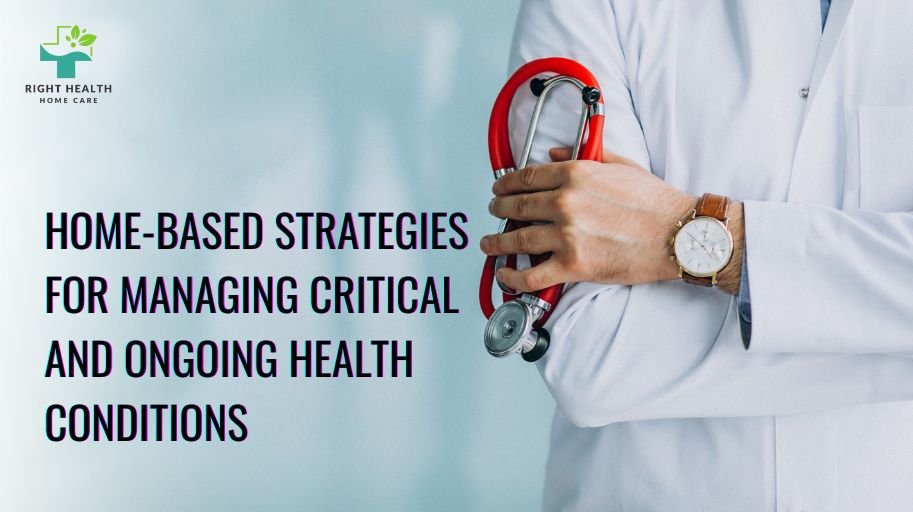Home-Based Strategies for Managing Critical and Ongoing Health Conditions
Taking care of severe and long-term medical conditions at home is becoming both required and preferable for many families. No matter the reasoning, mobility issues, financial constraints, or the need for comfort—home-based care offers a compassionate and useful approach to long-term health management. From diabetes and heart disease to cancer recovery and respiratory disorders, effective at-home methods may significantly enhance quality of life and health results. This article examines doable and tested strategies for comfortably treating serious and chronic illnesses.

- Making a Customized Care Strategy
- Creating a customized care plan is the first and most important step. A home care nurse, if applicable, as well as physicians and specialists should be consulted during the creation of this plan. It needs to include:
- Schedules for medications
- Requirements for diet.
- Exercise suggestions.
- Red flags or warning indications.
- Emergency contact protocols
- Maximize Your Use of Technology
Modern technology considerably aids in the monitoring and treatment of chronic medical conditions. Examine the resources listed below:
- Wearable technology: Heart rate, oxygen level, and sleeping habits can all be tracked by fitness trackers and smartwatches.
- Remote Monitoring Devices: Digital blood pressure monitors, pulse oximeters, and blood glucose readers are examples of devices that can provide information to healthcare professionals.
- Telemedicine platforms: They provide timely clinical guidance and do away with the necessity for travel.
- Stress the Management of Medication
Medication errors or missing doses can be fatal for patients with long-term conditions. The following strategies can help increase drug adherence:
- Make use of pill organizers that have times and dates written on them.
- Keep a current medication record that details the frequency and dosage.
- have a caregiver verify dosages, especially for vital drugs like anticoagulants or insulin.
- use medication tracking apps or set up mobile reminders.
- Make eating and drinking enough water a priority.
A healthy diet that is customized for all individuals is the cornerstone of efficient health care. For instance:
- Diabetes: Pay focuses on meals that are low in glucose and complex calories.
- Cardiovascular Issues: Reduce processed foods, salt, and saturated fat use.
- Recover in Cancer: Eat a lot of protein to help heal tissues that are injured.
- Integrate Mild Exercise and Mobility Support
Even having serious medical conditions, leading an active lifestyle helps to promote mental wellness, circulation, and muscle strength. Simple things you may do at home include:
- Chair exercises
- Short walks in the garden or indoors.
- lung-healthy breathing routines.
- Stretching or doing yoga may help you become more flexible.
- Maintain a Clean and Safe Environment
A clean home is essential for those with infections or problems with breathing. Put these into practice:
- Clean high-touch surfaces on a regular basis.
- Maintain sufficient air flow in rooms.
- eliminate trip risks such as loose wiring or rugs.
- provide grab bars to toilets to enhance safety.
- Encourage mental and emotional health.
Emotional health is frequently harmed by persistent illnesses. Depression, annoyance, and loneliness are frequent emotions. Promote mental health by:
- Fostering open discussion
- Regularly arranging social connections, whether in person or digitally.
- taking part in lighthearted or meaningful hobbies.
- making therapy or support groups accessible
- Utilize Skilled Home Health Care Services
Professional help may be required for wound care, intravenous medication, physical rehabilitation, or end-of-life care. Employing a skilled palliative care team, home nurse, or physiotherapist guarantees:
- Improved monitoring of vital symptoms
- Professional treatment delivery.
- less strain on family caregivers
- Teach the Family Members and the Caregiver
Everyone providing care needs to be adequately trained. This involves being able to:
- Use medical equipment
- Recognize signs of an emergency
- Treat illnesses or conditions requiring hygienic measures; administer basic first aid;
- Be Ready for Anything
Every household should have an emergency plan. Maintain these necessities:
- A list of emergency contacts, such an ambulance, local hospital, or primary care physician
- Identification, prescription drugs, and medical records in a travel bag
- A plan for transportation if an urgent hospital stay is necessary
Conclusion
Serious and persistent illnesses can be treated at home with the correct methods. It calls for empathy, organizational abilities, medical understanding, and access to practical resources. By providing emotional support, creating safety and wellness resources, and creating a workable plan, families can help their loved ones live in peace and dignity at home.

